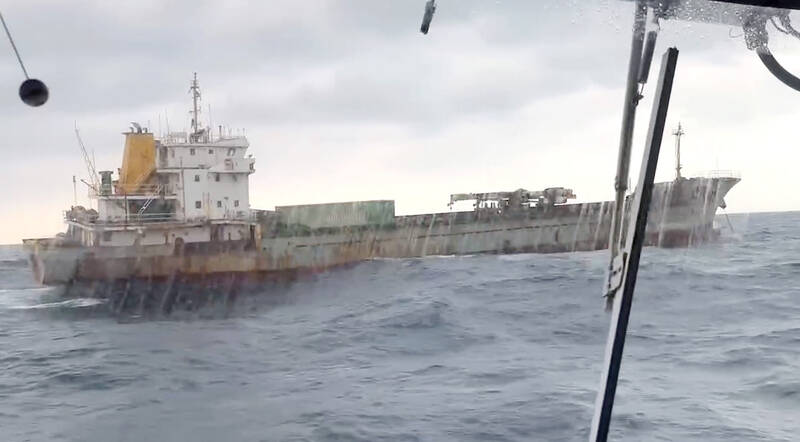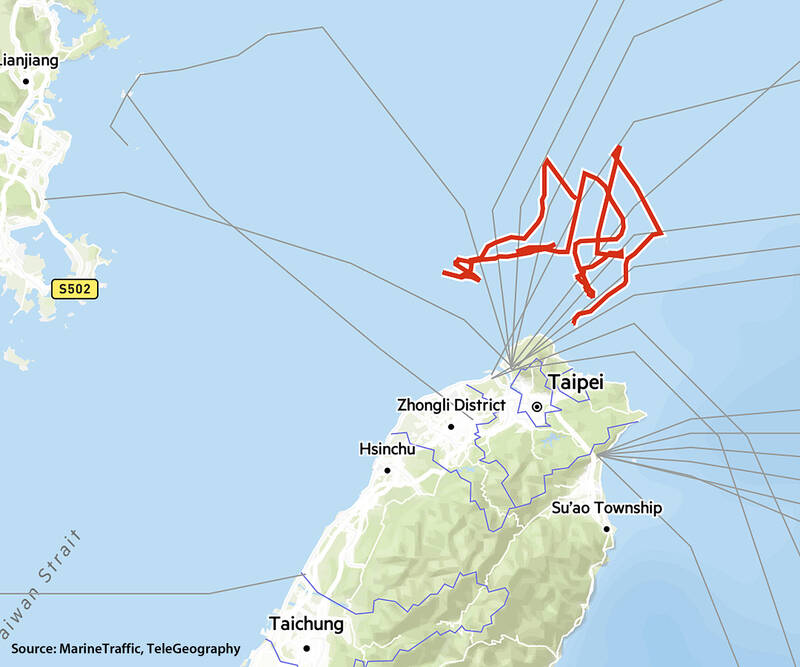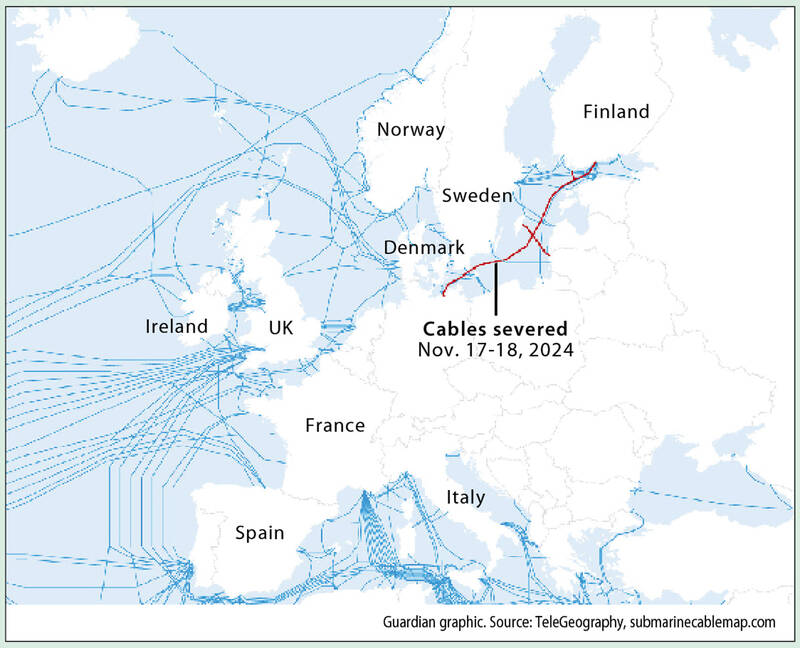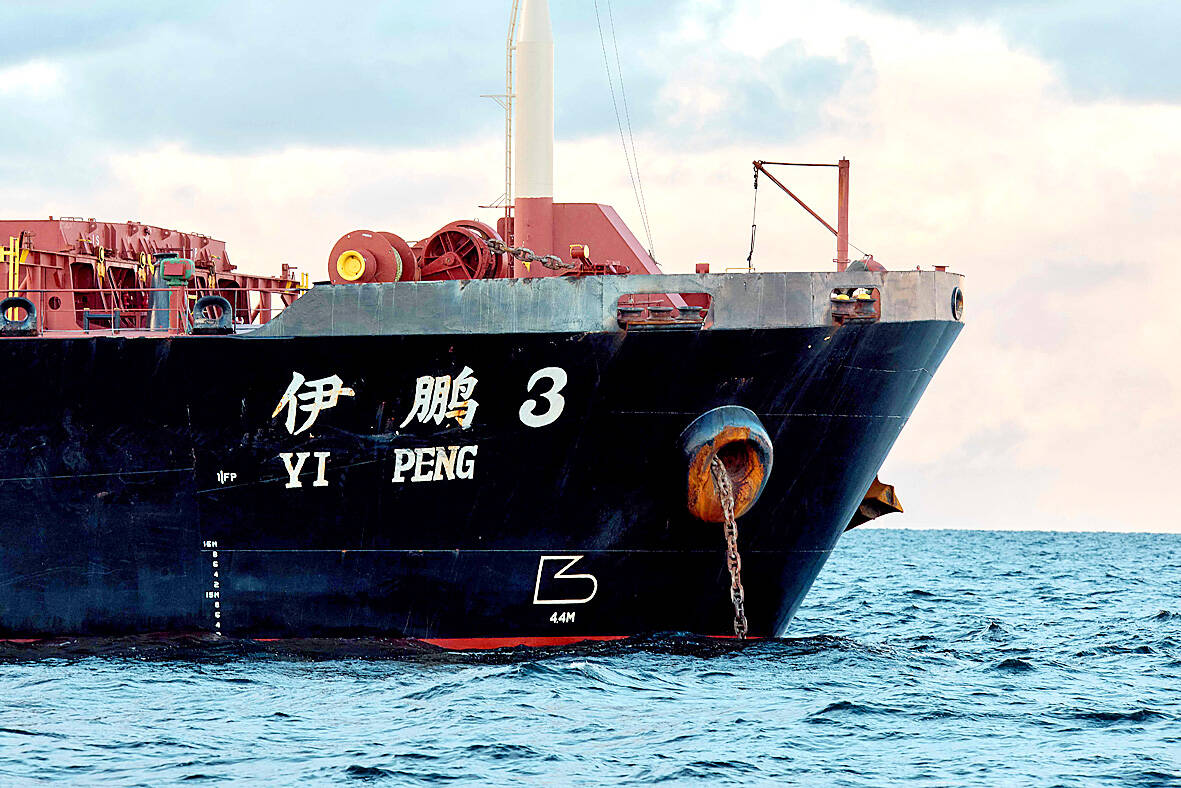A Cameroon-flagged cargo vessel “Shunxin-39” was believed to have caused damage to an undersea cable of Taiwan telecoms operator Chunghwa Telecom on the morning of Jan. 3. It was suspected that the Chinese merchant ship, which was registered with the nationality of another country, deliberately cut off the cable by dragging the anchor over it.
While the incident is still under investigation, China has a long history of using maritime tactics to sabotage Taiwan’s infrastructure.
In February last year, two cables linking Taiwan to its outlying Matsu Islands were damaged within days of each other by a Chinese fishing boat and a Chinese cargo vessel, causing slower Internet connections and dropped phone calls, in what one analyst described as a dry run for an “invisible blockade” of Taiwan.

Photo courtesy of Coast Guard Administration 照片:海巡署提供
A report by Taiwan’s National Audit Office this year said foreign ships had damaged cables linking the country with its outer islands 36 times since 2019, with 12 incidents registered last year. The damage was caused by a variety of vessels including fishing boats, cargo boats and sand dredgers.
The incident was believed to be a Chinese ploy to gauge the point at which the international community would draw a red line in an attempt to escalate its “gray zone” tactics.
The geopolitical backdrop to the current threat against undersea cables is the Russian invasion of Ukraine, China’s behavior towards Taiwan, and the Israel-Gaza war, but they have long been an obvious target.

Photo: Screen grab from Financial Times 照片:擷圖自金融時報
In November, a perpetrator cut two undersea cables in Sweden’s exclusive economic zone. The incident followed a similar one just over a year previously, affecting an undersea cable and one pipeline in the exclusion zones of Sweden, Finland and Estonia. And on Christmas Day last year, several cables in the Gulf of Finland were cut by a shadow vessel, Finnish authorities say.
Germany and Finland launched a probe on Nov. 18 last year after an undersea cable linking the countries was severed, warning of the threat of “hybrid warfare” amid heightened tensions with Russia.
During last year, “there were 500 suspicious incidents in Europe. Up to 100 them can be attributed to Russia, hybrid attacks, espionage, influence operations,” said Czech Foreign Minister Jan Lipavsky.

Photo: Screen grab from the Guardian 照片:擷圖自衛報
The West has accused Moscow of being behind a string of sabotage attacks on European soil aimed at deterring Ukraine’s backers from sending support to Kyiv.
NATO Secretary General Mark Rutte said on Dec. 4 last year after talks with NATO foreign ministers the alliance had agreed on “proactive measures” to counter Russia’s campaign of hybrid attacks against its members. “Allies are working very hard to make sure when it comes to sabotage, cyber-attacks, energy blackmail, that we take all the measures necessary to counter that.”
Sabotaging or manipulating undersea cables is not a new tactic. As early as 1898, during the Spanish-American war, US navy cut the telegraphic cable off the coast of Cuba to disrupt the enemy’s communications.

Photo: AFP 照片:法新社
According to Danish press reports, the US listened in via Denmark’s subsea network on communications from four countries — Germany, Sweden, Norway and France — between 2012 and 2014, including then-chancellor Angela Merkel.
Currently, undersea fiber optic cables transport 98 percent of global digital data. Undersea cables ferry data of all kinds between the continents, “transmitting everything from streaming videos and financial transactions to diplomatic communications and essential intelligence” according to a recent report from the US-based Center for Strategic and International Studies (CSIS).
Around 450 undersea cables are currently in operation worldwide, stretching for around 1.2 million km. Dozens more are in the planning stage.
Most countries with a coastline have at least one, according to a map from TeleGeography, a US-based firm specialising in telecoms data analysis. Only a few rare corners of the Earth such as Eritrea, North Korea and Antarctica are without subsea links.
(Lin Lee-kai, Taipei Times)
1月3日上午在台灣東北方基隆港外海,一艘懸掛喀麥隆國旗的貨輪「順興39號」,疑似下錨拖斷中華電信的海底電纜。外界懷疑中國商船註冊他國國籍,故意拖斷我國海底電信纜線。
雖然事件仍在調查中,但中國利用海上戰術破壞台灣基礎設施的歷史由來已久。
去年2月,連接台灣和馬祖列島的兩條電纜,在數天內被一艘中國漁船和一艘中國貨船破壞,導致網路連線速度變慢、電話中斷。一位分析師形容,這是中國對台灣實施「隱形封鎖」的演習。
台灣審計部今年公布的一份報告指出,自2019年以來,外國船隻損壞台灣與外島之間電纜的事件已有36次,去年就發生了12起。肇事的船隻種類多樣,包括漁船、貨船及挖泥船。
一般認為,這些事件是中國為試探國際社會的紅線而採取的策略,旨在升級其「灰色地帶」戰略。
目前威脅海底電纜的地緣政治背景是俄羅斯入侵烏克蘭、中國對台灣的動作,以及以色列—加薩戰爭,但海底電纜長期以來一直是明顯的目標。
去年11月,一名犯罪分子切斷了瑞典專屬經濟海域的兩條海底電纜。在這之前一年多已發生過類似情況,影響了瑞典、芬蘭及愛沙尼亞專屬經濟海域中的一條海底電纜和一條管線。芬蘭政府表示,去年聖誕節當天,芬蘭灣有數條電纜被一艘影子艦隊船隻切斷。
德國和芬蘭去年11月18日在連接兩國的海底電纜被切斷後啟動了調查,警告在與俄羅斯的緊張局勢加劇之際,可能發生「混合戰爭」。
去年,「歐洲發生了500起可疑事件。其中多達100起可歸因於俄羅斯、混合攻擊、間諜活動、認知作戰」,捷克外交部長揚.利帕夫斯基表示。
西方指責莫斯科是幕後黑手,在歐洲領土上進行一連串破壞性攻擊,目的是阻止烏克蘭的支持者向基輔提供援助。
北大西洋公約組織秘書長馬克.呂特去年12月4日與北約各國外交部長會談後表示,北約已同意採取「前瞻性措施」,來對抗俄羅斯對北約成員國的混合攻擊活動。「盟國正努力確保在遇到破壞、網路攻擊和能源勒索時,能採取一切必要措施加以應對」。
破壞或操縱海底電纜並非新手段。早在1898年美西戰爭期間,美國海軍就在古巴外海切斷電報電纜,來破壞敵方的通訊。
據丹麥媒體報導,2012年至2014年間,美國透過丹麥海底網路監聽了來自德國、瑞典、挪威和法國這四個國家的通信,其中包括當時的德國總理安格拉.梅克爾。
目前全球98%的數位資料是透過海底光纖電纜傳輸。根據美國戰略與國際研究中心(CSIS)最近的一份報告,海底電纜在各大洲之間傳輸各種資料,「傳輸從串流媒體視訊、金融交易,到外交通訊和重要情報的所有內容」。
全球運作中的海底電纜目前約有450條,總長度約為120萬公里。還有數十條在規劃中。
專門從事電信數據分析的美國公司TeleGeography的地圖顯示,大多數有海岸線的國家都至少有一條海底電纜。地球上只有厄利垂亞、北韓和南極洲等少數幾個角落沒有海底連線。
(台北時報林俐凱)

In an effort to fight phone scams, British mobile phone company O2 has introduced Daisy, an AI designed to engage phone con artists in time-wasting conversations. Daisy is portrayed as a kindly British granny, exploiting scammers’ tendency to target the elderly. Her voice, based on a real grandmother’s for authenticity, adds to her credibility in the role. “O2” has distributed several dedicated phone numbers online to direct scammers to Daisy instead of actual customers. When Daisy receives a call, she translates the scammers’ spoken words into text and then responds to them accordingly through a text-to-speech system. Remarkably, Daisy

Bilingual Story is a fictionalized account. 雙語故事部分內容純屬虛構。 Emma had reviewed 41 resumes that morning. While the ATS screened out 288 unqualified, she screened for AI slop. She could spot it a mile away. She muttered AI buzzwords like curses under her breath. “Team player.” “Results-driven.” “Stakeholder alignment.” “Leveraging core competencies.” Each resume reeked of AI modeling: a cemetery of cliches, tombstones of personality. AI wasn’t just changing hiring. It was draining the humanity from it. Then she found it: a plain PDF cover letter. No template. No design flourishes. The first line read: “I once tried to automate my

Every May 1, Hawaii comes alive with Lei Day, a festival celebrating the rich culture and spirit of the islands. Initiated in 1927 by the poet Don Blanding, Lei Day began as a tribute to the Hawaiian custom of making and wearing leis. The idea was quickly adopted and officially recognized as a holiday in 1929, and leis have since become a symbol of local pride and cultural preservation. In Hawaiian culture, leis are more than decorative garlands made from flowers, shells or feathers. For Hawaiians, giving a lei is as natural as saying “aloha.” It shows love and

1. 他走出門,左右看一下,就過了馬路。 ˇ He walked outside, looked left and right, and crossed the road. χ He walked outside and looked left and right, crossed the road. 註︰並列連接詞 and 在這句中連接三個述語。一般的結構是 x, y, and z。x and y and z 是加強語氣的結構,x and y, z 則不可以。 2. 他們知道自己的弱點以及如何趕上其他競爭者。 ˇ They saw where their weak points lay and how they could catch up with the other competitors. χ They saw where their weak points lay and how to catch up with the other competitors. 註:and 一般連接同等成分,結構相等的單詞、片語或子句。誤句中 and 的前面是子句,後面是不定詞片語,不能用 and 連接,必須把不定詞片語改為子句,and 前後的結構才相等。 3. 她坐上計程車,直接到機場。 ˇ She took a cab, which took her straight to the airport. ˇ She took a cab and it took her straight